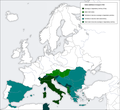English: Imperial ambitions of Fascist Italy in Europe, 1936. The Fascist regime also sought to establish protective patron-client relationships with Austria, Hungary, Romania, and Bulgaria. (Robert Bideleux, Ian Jeffries. A history of eastern Europe: crisis and change. London, England, UK; New York, New York, USA: Routledge, 1998. P. 467). In Eastern Europe, the Fascist regime held imperial designs on Albania, Dalmatia, Slovenia, Croatia, Bosnia and Herzegovina, Vardar Macedonia, and Greece based on the precedent of previous Roman dominance in these regions.(Robert Bideleux, Ian Jeffries. A history of eastern Europe: crisis and change. London, England, UK; New York, New York, USA: Routledge, 1998. P. 467). Dalmatia and Slovenia were to be directly annexed into Italy while the remainder of the Balkans was to be transformed into Italian client states.(Allan R. Millett, Williamson Murray.
Military Effectiveness, Volume 2. New edition. New York, New York, USA: Cambridge University Press, 2010. P. 184.).
In Spain in July 1936, Francisco Franco of the Nationalist faction in the Spanish Civil War requested Italian support against the ruling Republican faction, and guaranteed that if Italy supported the Nationalists, that "future relations would be more than friendly" and that Italian support "would have permitted the influence of Rome to prevail over that of Berlin in the future politics of Spain" essentially saying that Spain would be a client state of Italy. (Sebastian Balfour, Paul Preston. Spain and the Great Powers in the Twentieth Century. London, England, UK; New York, New York, USA: Routledge, 1999. P. 152.).
To the north of Italy, the Fascist regime in the 1930s had designs on the largely Italian-populated region of Ticino and the largely Romansch-populated region of Graubünden in Switzerland (the Romansch are a people with an Latin-based dialect).(John F. L. Ross. Neutrality and International Sanctions: Sweden, Switzerland, and Collective Security. ABC-CLIO, 1989. P. 91.) The Fascist regime accused the Swiss government of oppressing the Romansch people in Graubünden.(John F. L. Ross.
Neutrality and International Sanctions: Sweden, Switzerland, and Collective Security. ABC-CLIO, 1989. P. 91.) Mussolini argued that Romansch was an Italian dialect and thus Graubünden should be incorporated into Italy.(Carl Skutsch.
Encyclopedia of the world's minorities, Volume 3. London, England, UK: Routledge, 2005. P. 1027.).

